South Korean Navy (ROKN)
 Republic of Korea Navy 1948-1990: Around 130 ships
Republic of Korea Navy 1948-1990: Around 130 ships
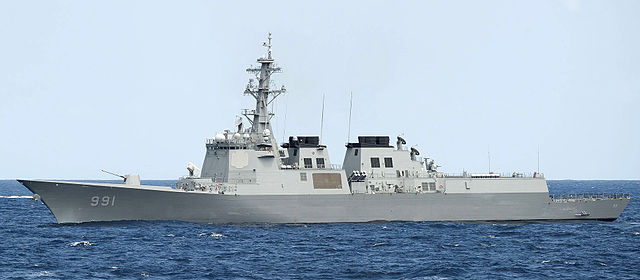
Seljong the Great class DDs, the pride of the South Korean Navy today. There was a long road up to this state.
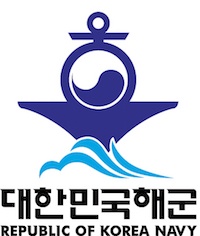 The Republic of Korea Navy (ROKN) is today the third largest Asian fleet after China and Japan. An heavyweight of the Asia-Pacific region which strength is directly linked to the economic miracle for the 1990s, up to this day, with a two digits growth. Its fleet dwarf the actual North Korean Navy and deploying 150 ships and 70 aircraft served by circa 70,000 active duty personnel (and 29,000 marines).
The Republic of Korea Navy (ROKN) is today the third largest Asian fleet after China and Japan. An heavyweight of the Asia-Pacific region which strength is directly linked to the economic miracle for the 1990s, up to this day, with a two digits growth. Its fleet dwarf the actual North Korean Navy and deploying 150 ships and 70 aircraft served by circa 70,000 active duty personnel (and 29,000 marines).
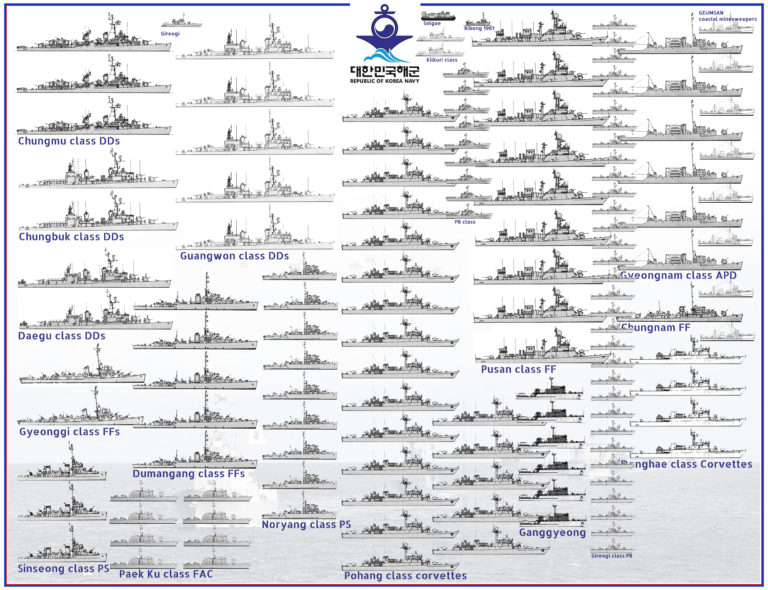
Poster of the Cold War Korean ships V.1 (less amphibious crafts, shipts and small patrol boats)
After a long cold war transition period where the navy operated US ships and was modelled after the USN model, including Marines, and academy, closely integrated into the USN local defence policy through exercises, the ROKN was seen as an essential part of the defensive ring against the Warsaw pact and later the Sino-North Korean alliance. Today well-served by the world’s largest shipbuilding industry, ROKN’s stepped up its naval program and boasts some of the strongest AEGIS missile destroyers afloat (ROKS Sejong the Great class).
Origins of the Republic of Korea Navy
Ancestry: Prowesses of the ancient Korean Navy
Ancestry: Prowesses of the ancient Korean Navy
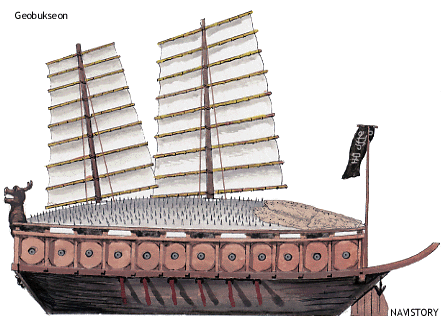
Geobukseon, or “turtle boat” one of the most amazing Korean contribution to naval history: Arguably the first ‘ironclad’ and representative of ships winning a desperate battle against overwhelming opposition of the Japanese. (author’s illustration).
From the Marine Defense Group to ROKN
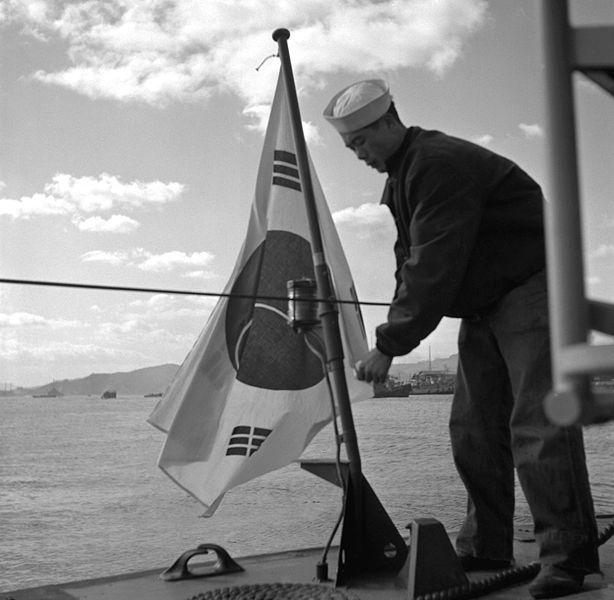
A ROKN sailor places a S. Korean naval ensign on a torpedo boat, after its transfer by the U.S. in the midst of the Korean War
The ROKN was born in the same circumstances that created both Koreas after the status quo of 1945 between advancing allied troops, US and British in the south and Soviet in the north at the end of the war, liberating the country from Imperial Japanese troops that occupied it since 50 years. A demarcation line was created, and on November 11, 1945, Marine Defense Group. It was created by Sohn Won-yil, former merchant mariner and well-connected, as the son of the Methodist minister and independence activist Sohn Jung-do. This was a modest force which only task was to be a coast guard to guarantee territorial waters from any incursion, an safeguard fishery areas as well.
The Marine Defense Group even was coupled with the creation of an academy at Jinhae. It was financed partially by the US to acquire 36 ships, mainly ex-IJN small ships captured and USN minesweepers acquired through US Forces present in the country. The ROKA (Army) was created at the same time.
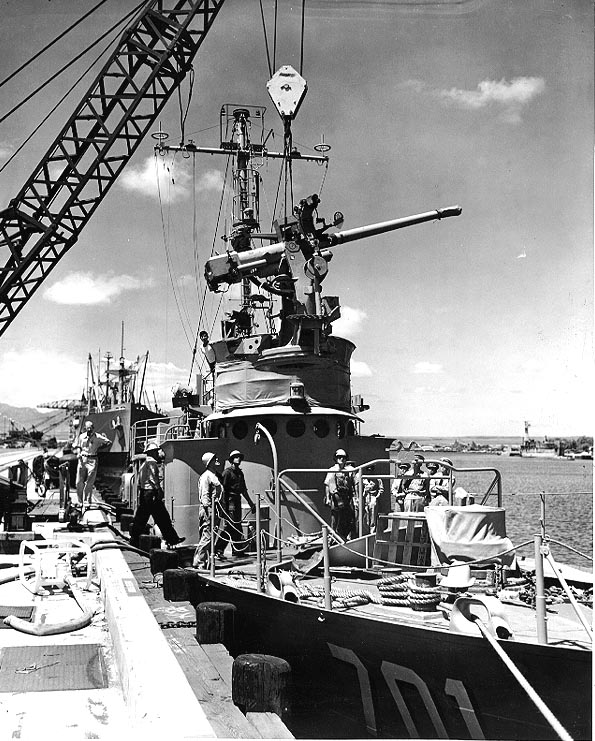
PC-701 Pak Tu San being rearmed in Hawaii in March 1950 prior to departure for Korea
Industrial Might
South Korean shipbuilding industry was gradually rebuilt with US assistance. There were four shipbuilders, at Ulsan (Hyundai or Hyeondae), founded in 1972, but which activity declined since 2011, after the economical crisis, Korea SB (HHC) at Bongnae-Dong or Hanjin heavy industries Co Ltd. in Pusan (now STX), Daewoo at Okpo (1972) but the most revealing is Korea Tacoma at Masan.
The latter was built to fulfill the government’s Long-term Shipbuilding Promotion Plan in the 1970s, with assistance of the US-based Tacoma shipyard. Settled in Masan free export zone it could deliver 15,000 GRT worth of tonnage and produce steel and aluminum ships as well at the smaller East Sea shipyard (Now Hanjin heavy industries, Ulsan in Yong-jam-dong).
Hyundai shipbuilding industries and its plethora of subcontractors and suppliers is now claiming for about 10% of all South Korean exports. In 2007 already, it delivered circa 37% of global ship orders but did not even existed in 1968. In October 2019, its orders totalled 1.29 million compensated gross tons. Such is the amazing growth observed in the country, and we did not need to recall one of its lighthouse product, Samsung’s smartphone.
Which such industrial and financial backup the only limitation now for the ROKN growth is manpower, but it’s closing to Japan and certainly not going to recede as Chinese naval ambitions are equally fierce.
The Cold War ROKN

PCC-783, similar to the sunken Cheonan, the most serious incident in a long list with North Korea.
Basically the fleet went through three gradual steps, also reflecting on a huge increase in funding and capabilities over the course of the cold and and in the third period from 1990 to this day where it expanded almost four fold.
What is called ROKN or “Republic of Korea Navy” was established as the Marine Defense Group on November 11, 1945. Sohn Won-yil, former merchant mariner, son of the minister (and independence activist Sohn Jung-do) was in charge of the organization of a first defense structure, the Marine Defense Group, in Seoul. This helped setup the Korean Coast Guard and Academy at Jinhae. The Coast Guard would be provided for enough fundings to acquired 36 patrol boats, ex-japanese and USN mineweepers after they cleaned up the maritime lanes in the area. Later, through the US Army Military Government in Korea and in accordance with the newly formed South Korean government in August 15, 1948, the Coast Guard became the original ROKN, with Sohn appointed as Chief of Naval Operations. By April 1949,following the US example, the Marine Corps (ROKMC) was established also at Jinhae.
In October 1949, ROKN needed to bolster its ASW capacity and acquired from the US a single 600-ton submarine chaser, former PC-823. It was obtained by funds raised among the navy personnel. Renamed ROKS Baekdusan it became the largest warship of the new navy.
Build-up in the Korean War
The war started on June 25, 1950 and since the beginning the Republic of Korea Navy (ROKN) took an active, successful and aggressive part in it. In 1950, the ROKN personal was no more that 6,956 personel, manning 33 vessels of small tonnage, dawrfed by the 13,700 men and 110 ships of the North Korean navy. However the USN and its allied more than compensated for that. Thanks to this support, the ROKN took control of the coastal area being part of a UN blockading task force (Task Force 95). In July 1953, the war ended with an armistice. Meawnhile the ROKN acquired 28 ex-USN ships, notably five Tacoma-class frigates, a precious addition. The ROK fleet was established in September 1953, taking charge of the operations and training.
First step: From nothing to a coastal force
ROKN was bolstered with many US- WW2-era ships loaned and often acquired later, and the navy grew steadily and spectacularly from 1955 to 1960. Indeed 42 ex-USN warships joined the fleet, notably two ex-Cannon class DEs.
Ships acquisitions
Another milestone was reached in May 1963, when the first ROKN entered service, Chungmu (DD 91) (Fletcher-class), and two others in 1963-68 and this went on until 1981, culminating with the transfer of nine modernized USN Allen M. Sumner-class and Gearing-class DDs as FRAM I/II conversions. Although decommissioned in US service they were equipped with ASW helicopters and had missile capabilities, like Harpoons and ASROC. In the 1970s the Korean Navy transitioned to a green water navy.
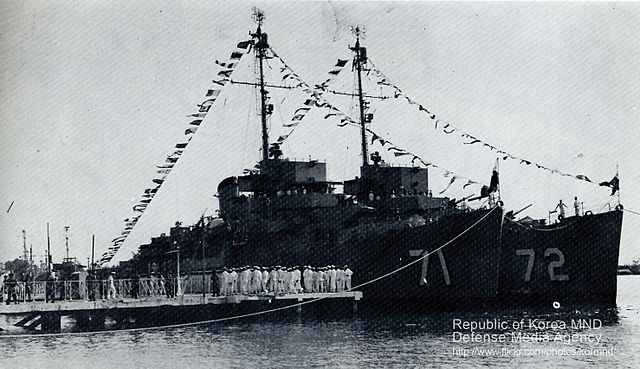
Ex-USN Cannon-class destroyer escorts, transferred from Boston in 1956
Second step: From coastal to green water navy
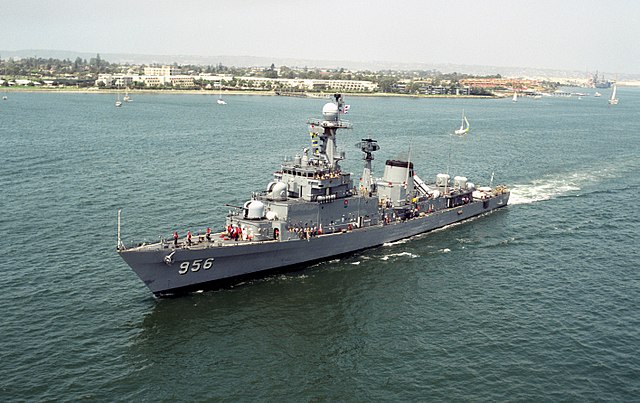
ROKS Kyong Buk, locally built Ulsan-class frigate
Ships constructions
In the 1970s Park Chung-hee Administration launched the ambitious Yulgok Plan, eight-year national defense based on the domestic industries. Shipbuilding capabilities has been developed at that time by tight planning and ended with amazing crafts like the high-speed Baekgu and Chamsuri class vessels and in November 1972 tailored to intercept fast North Korean spy boats. But soon the Herculean effort put into shipbuilding capacity was about to pay off with the lead ship of the 2,000-ton Ulsan-class frigates being launched in 1980.
Soon were also delivered the 1,000-ton Donghae-class corvettes and the Pohang-class corvettes launched in 1982 and 1984. ROKN later launched the Dolgorae-class midget submarine, and Gojunbong-class LSTs, plus Wonsan-class minelayer and Ganggyeong-class minesweeper plus the Cheonji-class logistics support ship and Cheonghaejin-class submarine rescue ship to round this evolution to a blue water navy, consecrated in the late 1990s by no less than three new classes of powerful missile helicopter destroyers with oceanic capabilities and a new state-of-the art attack submarine.
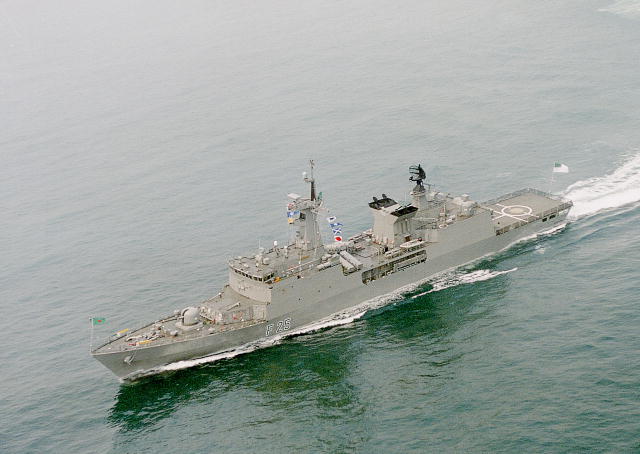
As a reminder of Korean export capabilities, the Uslan class frigates have been exported – Here the Bangladeshi BNS Bongobondu
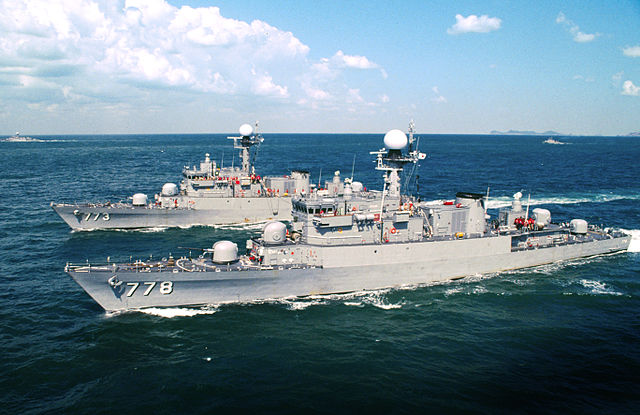
The numerous Pohang class corvettes built over almost two decades is an impressive achievement for a shipbuilding industry born just ten years prior.
The Korean Marine Corps
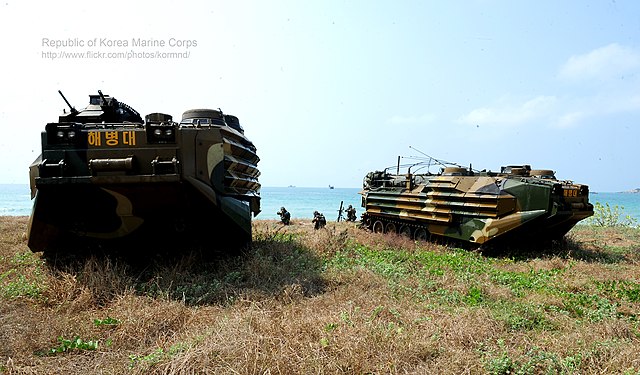
ROKN Marines at 2014 Cobra Gold Combined Exercise in Thailand, KAAV7A1 assault amphibious vehicles, a locally modified derivative of the LVTP-7. By November 1987, the ROKN Marine Corps HQ was re-established after being disbanded in October 1973 due to budgetary restrictions and in June 1993, i was moved from Seoul to the brand new Gyeryongdae complex, the “Korean Pentagon” in Gyeryong.
On April 15, 1949, ROKMC was founded at Deoksan airfield (Jinhae) and Lt Col. Shin Hyun-joon was appointed to create and lead the Marine Corps, promoted to Colonel in July. The ROKMC comprised rifle companies but was equipped with weaponry from the IJA, including the vintage 7.7 mm Type 99 LMG. It was recombined to form three rifle companies and has US Atmy advisers while doctrine mirrored the IJA Marines. In September two rifle companies were sent to Jinju followed by the third at Jeju-do for anti-guerilla operations, with soon a 37mm anti-tank platoon added. It was deployed during the Korean War, together with the Kokilhun Marine rifle battalion, sent to Kunsan in June 1950. Marines landed on Kueje Island on 23 August, and on 15 September the regiment landed at Red Beach, Inchon for a legendary fight in a legendary landing. At the end of the war its reputation as an absolute elite force was established, as on 27 July 1953 the ROKM personal had killed an estimated 22,070 PVA/KPA for 2,529 losses, a ten to one ratio.
It was reorganized in 1955, as the 1st Marine Division, of which the 2nd Marine Brigade actively particpated in the Vietnam war. The Blue Dragon Brigade (1965) and various South Korean special forces were also deployed, considerably reinforcing its elite image by working with the US Rangers and Green Berets. They participated in Operation Van Buren, the Battle of Tra Binh Dong, Operation Hood River, Operation Dragon Fire, Operation Pipestone Canyon and Operation Imperial Lake. In 1982, ROKMC established the ‘812th “Hammer” Unit’ to perform retaliation operations against the DPRK. Its motto was ‘Kill’em all, Let God sort’em out’ (…) and they have a training to match the USN Seals. In November 1987, the ROKM was re-established, as it has been eliminated in October 1973 and attached to the general Marine HQ.
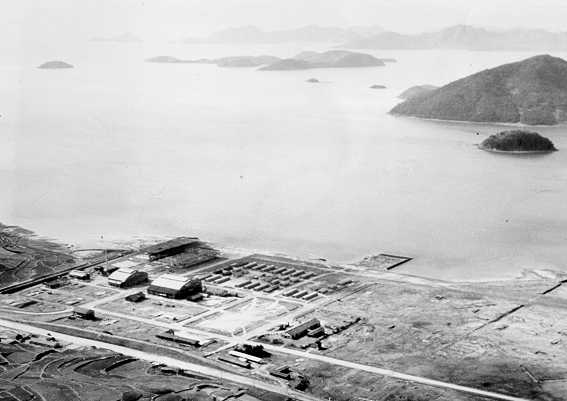
ROKN Marine Base Jinhae 1950, ROKM original HQ
The Korean fleet air arm
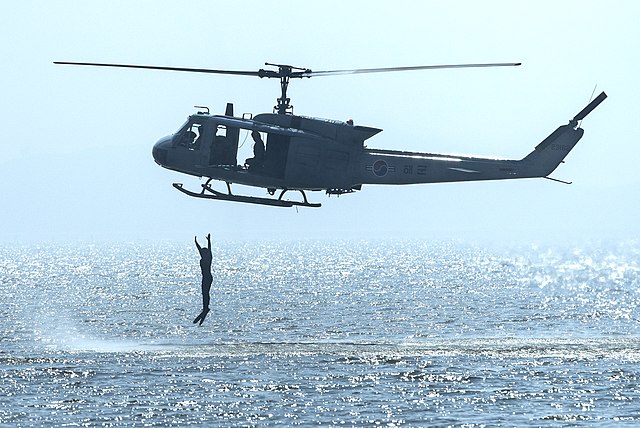
ROKMC’s 2nd DIV Gogang-Do Surface Infiltration Training from a Bell UH1
Development of a dedicated naval fleet air arm started from a naval base for SAR mostly and commandos infiltrations with eight Bell UH-1 (above), which entered service in 1978. It was furyther developed after the col war, with the Lynx Mk.99 (11, in 1991), locally-built Sikorsky UH-60P (by KAL-ASD, eight in 1994), adoption in 1995 of a fleet of eight long range patrol P-3C, eight more P-3CK locally modernized in the 2000s and five Reims-Cessna F406. Eleven Super Lynx Mk.99A were acquired in 1999 and eight AW159 Wildcat in 2017. The modern missile destroyers of the ROKN also operate helicopters as did the LAMPS-III FRAM destroyers back in the 1980s.
Third step: From green to blue water Navy
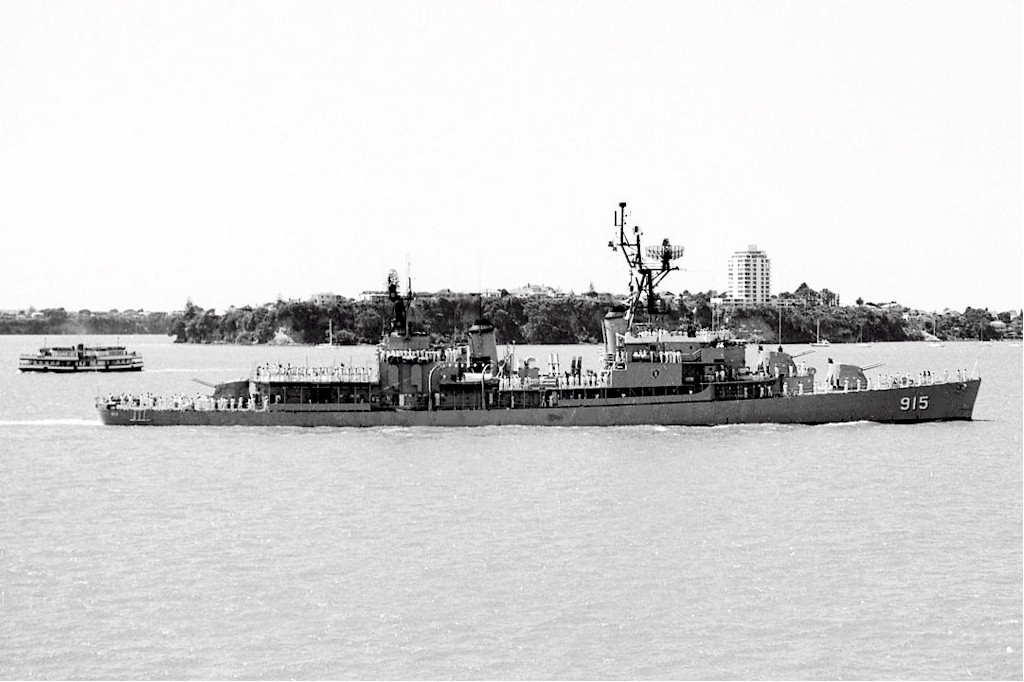
ROKS Chungbu DD915 (src navsource.org)
Before the post-cold war period, 1990s, the Korean Navy’s main strength laid in a collection of US-built WW2-era modernized destroyers, patrol ships and landing ships. So far the only products of the local shipbuilding industry has been the Ulsan class frigates and Po Hang and Dong Hae class corvettes, ‘Mazinger’ class patrol ships and the prototype of a serie of minehunter built in the 1990s, Kang Keong class. Soon the late transferred destroyers from the US were scheduled for replacement in the 2000s. The setup of a powerful local shipbuilding industry incarnated by Korea SB, Pusan, Korea Tacoma, Masan, Hyundai in Ulsan and Daewoo in Okpo would fit the bill for 10 to 50,000 tonnes ships of needed. The 18,000 tonnes Dodko and Marado are good examples of this scaling-up of the fleet.
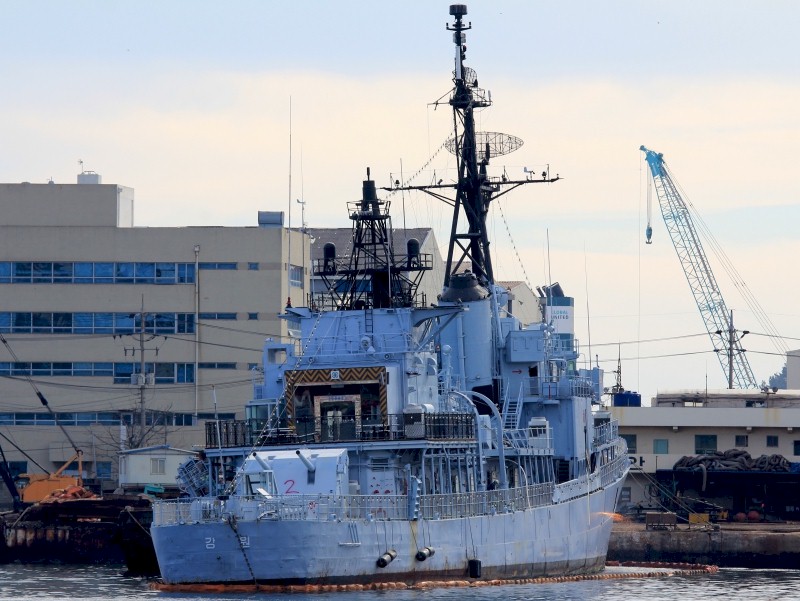
ROKS Kwangwon waiting to be dismantled in Busan, December 2016.
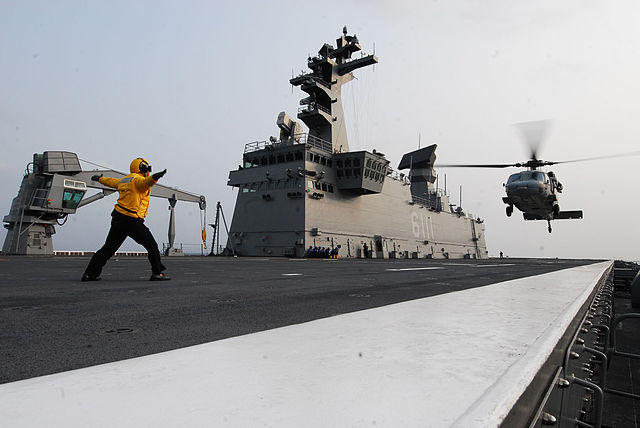
Air operation on the deck of ROKS Dodko. Her sister ship is currently on sea trials.
Cold war History
-Battle of Haeju (September 10, 1950): Small clash days before the Battle of Inchon between the ASW patrol boat PC-703 and converted NK minelayer and the latter sank.
-July 30, 1960: ROKS Gangwon (DE 72) sank the North Korean navy patrol craft PBS 371 off the coast of Geojin. The latter was caught in territorial waters. Many other incidents occured, especially in later period. For more see the North Korean Page.
During the Vietnam War, the ROKN dispatched the Naval Transport Group called “Seagull” and 2nd Marine Brigade called “Blue Dragon”
-January 19, 1967: ROKS Dangpo (PCE 56) was sunk by North Korean coastal artillery, north of the DMZ.
-April 1975, just before the Fall of Saigon, two ROKN LSTs evacuated South Vietnamese and South Korean civilians.
-June 1970, Navy broadcast vessel I 2 was captured by a North Korean patrol craft off Yeonpyeong Islands, Yellow Sea.
-February 22, 1974, Navy harbor tug YTL 30 capsized off Tongyeong with all hands lost.
Other incidents ocurred in the 1990s and post-cold war period after quiet 1980s: 1996, Incident of Gangeung: A failed inflitration with a midget submarine, 1998, Incident of Yosu, same scenario with a I-SILC-class semi-submersible infiltration vessel and 1999, 1st Battle of Yeonpyeong, incident of Amami-Ōshima in 2001, second Battle of Yeonpyeong in 2002, and more serious, the incident of Daecheong in 2009, with the sinking of the frigate ROKS Cheonan.
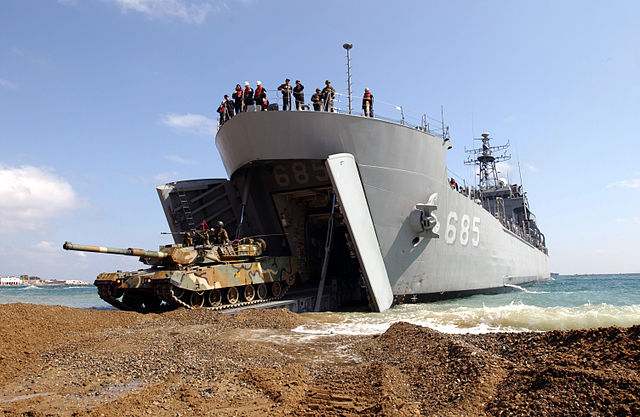
A K1A1 rolling of a modern Korean LST
Read more/Src
Conway’s all the world’s fighting ships 1947-95
en.wikipedia.org/wiki/Republic_of_Korea_Navy#Ships
www.globalsecurity.org/military/world/rok/navy.htm
www.globalsecurity.org/military/world/rok/industry-shipbuilding-3.htm
www.navy.mil.kr/mbshome/mbs/navy/index.do
www.navaltoday.com/search/South+Korea/
shipyards.gr/shipyards/search?searchword=korea&search_cat=1
en.wikipedia.org/wiki/Korea_Coast_Guard
navy.mil.kr/mbshome/mbs/eng/subview.do?id=eng_010300000000
www.youtube.com/user/MsRoknavy
www.globalsecurity.org/military/world/rok/ship.htm
Nomenclature of ROKN cold war ships
Conventional destroyers
 Chung Mu class destroyers (1963)
Chung Mu class destroyers (1963)
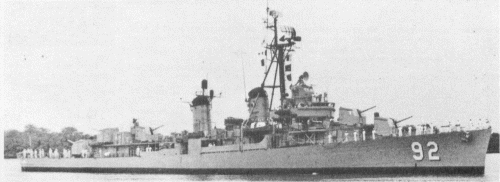
ROKN Seoul (DD912) in 1968 – src navypedia.
Built in 1943, the three Fletcher class destroyers USS Herben, Halsey Powell and Hickox built in Bath Iron Works, Bethlehem Staten island and Federal, Kearny were the first destroyers transferred to the ROKN, the first (renamed Chungmu and Seoul) two in April and May 1963 and a third (renamed Pusan) in November 1968. They had been modernized as ASW destroyers with new electronics and sonar. Chungmu and Pusan were armed with five 127/38 Mk 30, two twin 40/60 Mk 2 and a 40/60 Mk 1, two triple ASW 324 TT, and two 24-tubes (178) Hedgehog Mk 10/11 ASWRL, plus 2 DCR while ROKS Seoul AA comprised two quadruple 40/60 Mk 2 AA. They were leased until 1977 and then purchased. Pennant numbers were 91-93 and they were discarded in 1982 (Seoul), 1989 (Pusan) and used as training ship from 1898 (Chungmu) – current status unknown. Chungmugong was the posthumous name given to the great military commanders of the Joseon Dynasty.
 Chung Buk class destroyers (1972)
Chung Buk class destroyers (1972)
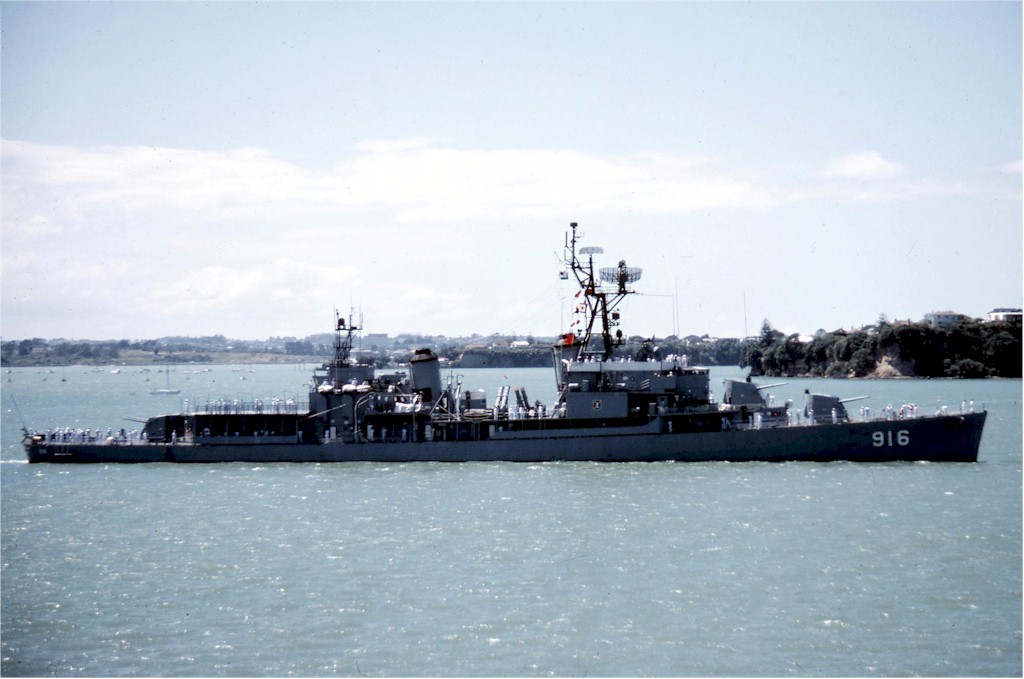
ROKS Jeongbuk (DD916) in Auckland in the 1980s – src navsource.org
As the Fletchers were an obsolete design in 1972 (The USN just were launching the modular, huge Spruance class), ROKS leased two bath Iron Works destroyers this year: Two Gearing FRAM II, former radar picket converted, USS Chevalier and E.F. Larson. They were acquired in July and October 1972.
Armament was similar to to the FRAM II standard, and comprised the same as FRAM II, but in 1976, a 20 mm Vulcan-Phalanx CIWS was installed on Chungbuk’s hangar roof, a twin 30/75 Emerlec-30 on her sister-ship and the next year, both were purchased. In 1979, Chungbuk and Jeongbuk were modernized, with two quadruple Harpoon SSM (8 RGM-84) canisters fitted with a small hangar and reinforced, enlarged flight deck for a light Alouette III helicopter (formerly it was a DASH drone). From 1986 to the late 1980s, both ships were fitted with an ULQ-6 ECM and T-Mk 6 Fanfare torpedo decoy, and a triple 20/76 Sea Vulcan and later Jeonbuk had a twin 30/75 and two triple 20/76 Sea Vulcan systems. Both were still in service in the late 1990s and Chungbuk was sold for scrap and dismantled in December 2000 while Jeongbuk was preserved and converted as a museum ship.
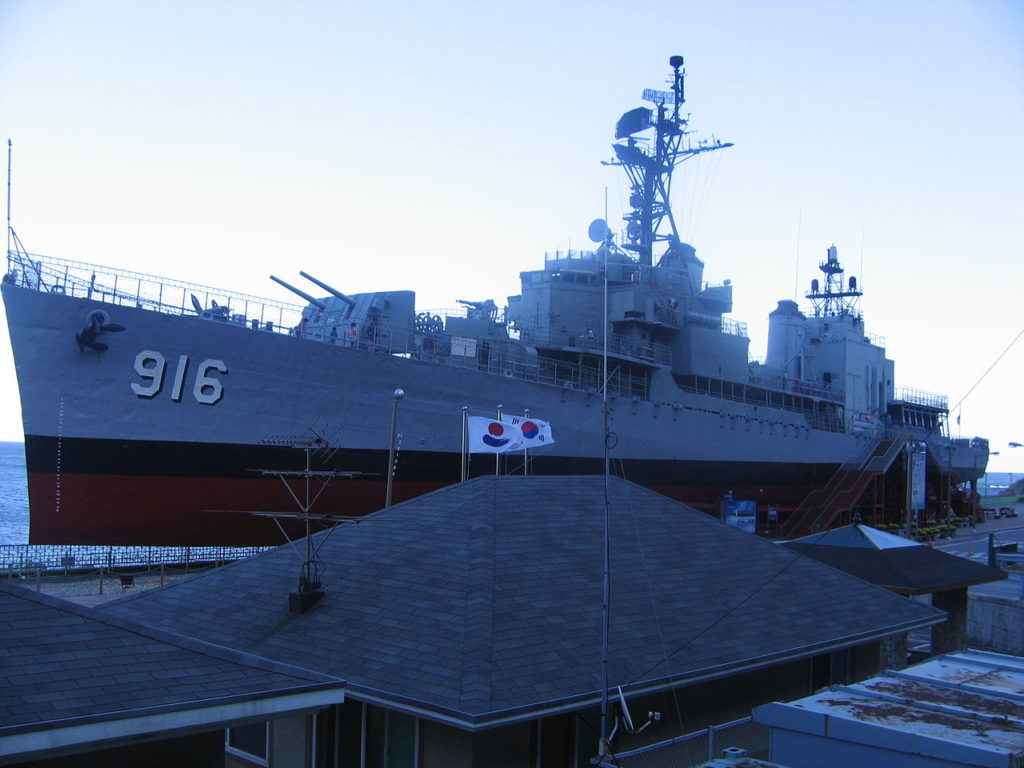
DD916 Jeonbuk as a museum ship as of today (cc).
 Dae Gu class destroyers (1973)
Dae Gu class destroyers (1973)
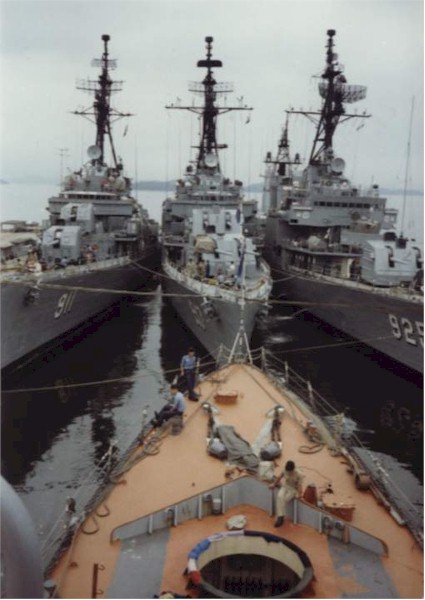
DD917 Daegu decommissioned in 2000, Jindae, with other FRAM type destroyers.
A year after in 1973 were acquired two modernized Allen M Sumner class destroyers, ex-Wallace L. Lind and De Haven, built in 1944 and both transferred in December 1973. They had been thoroughy modernized in the 1960s FRAM II standard, and were armed with three twin 127/38 Mk 38, two triple 324 ASW TT, two 24-rubes 178 Hedgehog Mk 11 ASWRL, one DCR and carried and electronic suite comprising the radars SPS-10, SPS-40, Mk 25 radars, SQS-29, SQA-10/29 sonars, WLR-1 ECM suite and two decoy RL.
They also had a small flight deck for a DASH and later LAMPS III helicopter. Both renamed Dae Gu and In Cheon were leased and purchased in 1977. Modernization included in 1976 a triple 20/76 Sea Vulcan, in 1978 and Alouette III helicopter plus revised hangar and flight deck and the next year two twin Harpoon SSM (4 RGM-84) canisters and in the early 1980s two twin 40 mm/60 Mk 1 AA guns. Incheon (DD918) was stricken in 1993 but DaeGu was still in operations in the 1990s, stricken in 2000.
 Kang Won class destroyers (1974)
Kang Won class destroyers (1974)
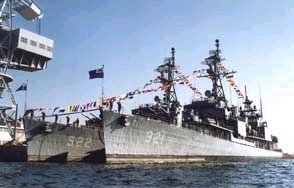
ROKN Kang Won and Kang Ju decommissioning ceremony in 2000, Chinhae, South Kyongsang Province.
Certainly the best remembered destroyers of the ROKN in the cold war were the five Kwangwon class destroyers, former Gearing FRAM I conversons. They were the former W.R. Rush, R.E. Kraus, New, Rogers, and N.M. Perry, transferred respectively in 1974, 1977, and 1981, and renamed (pennant 919-925) Kwangwon, Kwangju, Taejon, Jeongju and Kyongkai. As FRAM I ships they had been comprehensively rebuilt with a new bridge and superstructures, new electronics suite, revised armament, and a LAMPS helicopter.
Armament as transferred comprised on Taejon, kwangwon and Kwangju two twin 127/38 Mk 38, two triple 324 ASW TT, two Hedgehog Mk 11 ASWRL and a 1 DCR with the SPS-10, SPS-40, Mk 25 radars, SQS-23 sonar, WLR-1, ULQ-6 ECM suites and two decoy RL, while Jeongju and KyongKai, the 1981 batch, were armed with an octuple ASROC ASuR (17 RUR-5) in central position and their electronic suite included also the SPS-29 radar.
In 1979 the first three were armed with two quadruple Harpoon SSM (8 RGM-84C) canisters, and in the early 1980s they all received the ULQ-6 ECM suite, and on the first three a twin 40 mm/60 Mk 1, and two triple 20/76 Sea Vulcan systems plus an Alouette III helicopter with an enlarged hangar and strenghtened, widened flight deck.
In the 1980s other changes comprised the adoption of the T-Mk 6 Fanfare torpedo decoy and in the mid-1990s on Taejon and Kwang Ju the SPS-40 and DA-08 radars and on Kwang won the SPS-29 and DA-08 radar, SQS-23 sonar and DE 1191 sonar for Tae Jon, Kwang Ju, Kwang Won. All were listed extant in the later 1990s and were later stored at the National Security Experience Park, Jeongdongjin, Gangwon-Do. They had been scrapped in the 2000s.
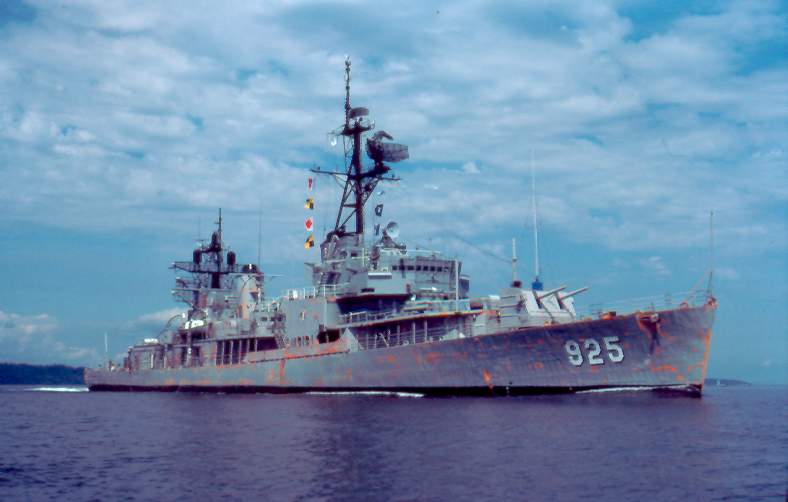
ROKS Jeongju (DD925) in 1981 – src navsource
https://www.navypedia.org/ships/korea_south/kos_index.htm
Frigates and lighter ships
 Du Man class frigates (1950)
Du Man class frigates (1950)
Ex-Tacoma class frigates transferred in 1950-52: Du Man, Apnok, Tae Tong, Nak Tong, Im Chin. They were amongst the 32 vessels of the class transferred to the USSR with lend-lease, returned to USN in Japan in 1949 and loaned to ROKN. No changes since their initial state, they grew obsolescent in the 1970s while two more were towed from Japan for cannibalisation in 1969. Apnok was damaged in a collision in 1952, sunk as target 1963. They were stricken circa 1974.
 Kyong Ki class frigates (1950)
Kyong Ki class frigates (1950)

Kyong ki and Kyong Won were former Cannon class (DET) escort destroyer from Tampa SB yard, transferred from Boston to the Korean navy in February 1956 and in 1977 stricken and transferred to the Philippine Navy. Note a single DET-class, former USS Holt, built at Dafoe Bay City was leased from 1963 and built outright by the Korean Gvt. on 15 November 1974, to be stricken in 1984.
 Ulsan class frigates (1980)
Ulsan class frigates (1980)
Ulsan, Seoul, Chungnam, Keongbuk, Cheonnam, Cheju, Busan, Chungju
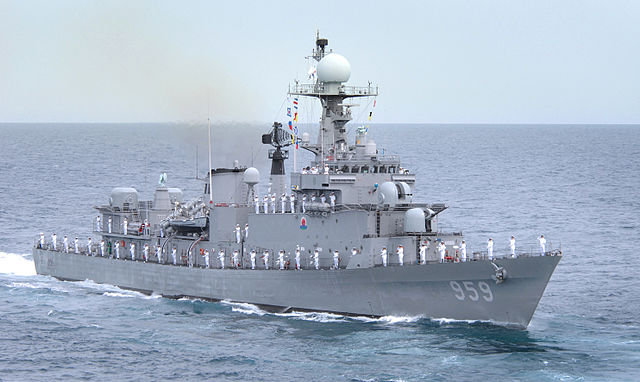
The Uslan class were probably the most important shipbuilding program of Korean History during the cold war. They were the first truly local large, sea going warships, entirely designed in South Korea and built by all the yards recently completed. The class comprised nine ships, well armed for their size, multi-purpose frigates. Machinery, armament and electronics were American or US-derived, but also British and Dutch for the radars and sensors. Only seven were active during the cold war as the first Ulsan, was launched in 1980 and completed in 1981 and after the first batch of three, another order was made in 1981 and another in 1984. Cheju, Busan, ChungJu were commissioned after the fall of USSR, the last two being launched in 1992.
Design-wise they had a steel hull but composite alloy superstructure. They were criticized for not having helicopter facilities however and their ASW capability was limited to two 324 mm ASW TT banks and two Deep Charges racks. Their AA was impressive however, and the Harpoon gave them noted anti-ship capabilities. The armament was purchased off-shelf like the fire guidance systems and optronics: The 76 mm were the OTO-Melara classic 76 mm superfast guns, completed in alternance by either US-built Emerlec twin guns or Breda 40 mm twin guns.
They had the British HSA Lior optronic directors, Combat data system 957-58 and Siemens/ferranti WSA 423. All ships were also fitted with the SQL-25 nixie torpedo decoys. An additionnal serie of eight was thought of to replace ex-US Destroyeres but India was given this extra serie, with many modifications.
Much larger Frigates displacing 3900 tonnes, for 135 m were planed for 1992n equipped with an helicopter hangar and flight deck for a Westland Super lynx model. The first was scheduled to be laid down at Daewoo, Okpo in mid-1992, and the class was known as the HDF-3500/KDX 2000 or DW 4000. Eventually the program evolved into fully-fledged Destroyers whereas Corvettes were built instead to the lower end.

Specifications:
- Displacement: 1495/1600 t standard, 2180 t FL, 2300 for 4 ships
- Dimensions: 105 (98pp) x 12 x 3.5 m
- Powerplant: 2 shaft CODOG 2 GE LM 2500 GT 54400 shp 35 knots 400 nm/18 knots
- Armament: 8 Harpoons SSM, 2x 76mm OTO, 8x 30mm/85 Emerlec/Breda 40mm/70
- Electronics: HSA DA-05, ZW-06, WM-28, SPS 10c, PHS-32, see notes
 Pohang class corvettes (1984)
Pohang class corvettes (1984)
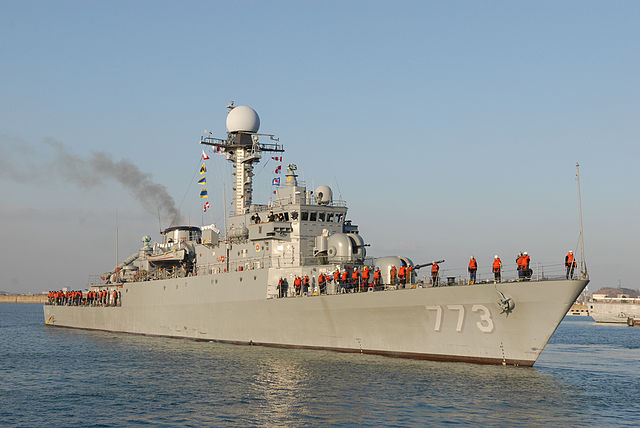
A kind of reduced version of the Uslan class, general purpose corvettes used first for coastal defense, with a total of 24 vessels built (only 12 remaining in service today, as of 2020). The earlier ones has been sold after being discarded in the 2000s (2009 to 2013). The first is still extant as a museum ship in the city of Pohang. Others were sold to Bolivia, Peru, Colombia, Egypt, the Philippines, and Vietnam (2). With a 950 tonnes displacement light they were heavily armed, with AA guns and a comprehensive electronics suite which was modified between the early and late ships.
The Pohang was completed in December 1984, and the last, Gongju, in July 1993 (Flight VI). Armament was comprehsenive and varied over time. The first ships carried a single OTO Melara 76 mm/62 compact cannons (on Flight II), replaced by the two of the same on Flight III – VI. The first serie also had two twin Emerson Emerlec-30 Oelikon 30 mm/75 KCB cannons, replaced on the next series on two twin OTO breda 40mm/70 cal and for antiship defence, the first serie was armed with two twin canisters MM-38 Exocet, same numbers of RGM-84 Harpoon Block 1B on Flight IV and same of SSM-700K Haeseong (on Flight V – VI). For anti-submarine warfare, two three twin Mark 32 Surface Vessel Torpedo Tubes (on Flight II – IV) or the same of Korean built KMk 32 TTs with K745 Chung Sang Eo torpedoes on Flight V – VI. As usual they also carried 12 Mark 9 depth charges in racks and for AA defense they also carried two short-range Mistral MANPADS, while for landings and shore operations or coast guard intimidation, they were fitted also with two K6 HMG or M60 GPMG.
Electronics side, the suite varied among the armament and series: Surface search radar AN/SPS-64 (Flight II – IV), AN/SPS-55 (Flight V), SPS-300K (Flight V – VI). For Fire control system: Signaal LIOD (Flight II – III), Radamec 2400 (Flight IV – VI) and for Combat system SEWACO ZK (Flight II – III), WSA-423 (Flight IV – VI). For the search radar, it was the Marconi S1810 (Flight IV – VI) and the tracking radar was the Marconi ST1802 for late series only. The sonar for all was the ANSQS-58. For decoys they had four Mel Protean Chaff Launchers and from the III flight SLQ-260KA2 and SLQ-261K TACM.
Specifications:
- Displacement: 950 t standard, 1200-1300 t FL
- Dimensions: 88 x 10 x 2.9 m
- Powerplant: 2 shaft CODOG, 2 CP props, 1 GE LM 2500 GT, 2 MTU diesels
- Performances: 27800 -6200 shp 35 knots 400 nm/18 knots
- Armament: 76 mm OTO, 8x 30mm/85 Emerlec/Breda 40mm/70, see notes
- Electronics: HSA DA-05, ZW-06, WM-28, SPS 10c, PHS-32, see notes
 Dong Hae class corvettes (1982)
Dong Hae class corvettes (1982)
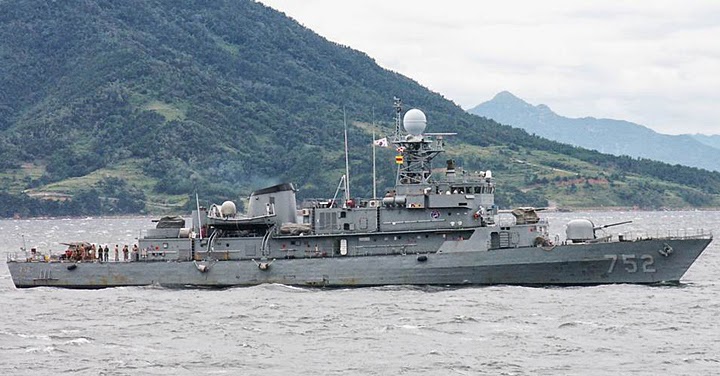
ROKS Su Song
Four corvettes built to serve as coast guard ships. Each is armed with a single Oto Melara 76 mm compact gun and three AA guns while the two 324 mm ASW torpedoes two six-charges racks were optional (they were fitted anyway). In wartime the electroniocs suite would have been bolstered and missiles added, either MM-38 exocet or Harpoon missiles. The TT fired Mark 32 triple torpedo tubes but there was a provision for 6 Mark 46 torpedoes and the depht charges were of the Mark 9 type.
They were based on the later Pohang class but “budget-savyy”. To gain time, each of the four ship were built in separate yards: ROKS Donghae (PCC-751) (launched 1982), Suwon, Gangneung, and Anyang in 1983, named after cities. They were decommissioned in 2009 and 2010, the first three being disposed of in support of fleet training exercise. The third was deactivated in 2011 but donated to Colombia, where she took the name CM-55 ARC Nariño. She is still active.
Specifications:
- Displacement: 1076 t standard, 1186t FL
- Dimensions: 78.1 x 9.6 x 2.6 m
- Powerplant: 2 shaft CODOG, 2 CP props, 1 GE LM 2500 GT, 2 MTU diesels
- Performances: 26,800+6,260 shp, 31 knots 4000 nm/18 knots
- Armament: 1x 76 mm OTO, 4x 30mm/85 Emerson, 2×3 324 mm TT, 12 DC
- Electronics: AN/SPS-64, Signaal WM-28 DCR, SEWACO ZK, LIOD, SAN 15 TACAN, Thorn EMI/NobelTech, Mel Protean CL, EDO 786 sonar
- Crew: 96
South Korean patrol boats and ships
 Han Kang class patrol corvettes (1985)
Han Kang class patrol corvettes (1985)
These “patrol corvettes” were based on the Po Hang design, downgraded Coast guard vessels in peacetime but requisitioned and rearmed in times of war. 324 mm ASW TTs and DC racks were planned but not fitted. Project HDC 1150 as it was known was not followed by a serie. A single ship therefore was built, 1005 Hank Kang built at Korea SB of Pusan, in service in December 1985.
- Displacement: 1000 t standard, 1200t FL
- Dimensions: 87.7 x 10 x 2.88 m
- Powerplant: 2 shaft CODOG, 1 GE LM 2500 GT, 2 MTU diesels
- Performances: 27,800+6,200 shp, 31 knots 4000 nm/15 knots
- Armament: 1x 76 mm OTO, 1x 40mm Mk3 bofors, 2×3 CIWS Vulcan
- Electronics: Raytheon SPS-64(V), HSA WM-28
- Crew: 72
 Chamsuri (PKM 268) PBs (1978)
Chamsuri (PKM 268) PBs (1978)
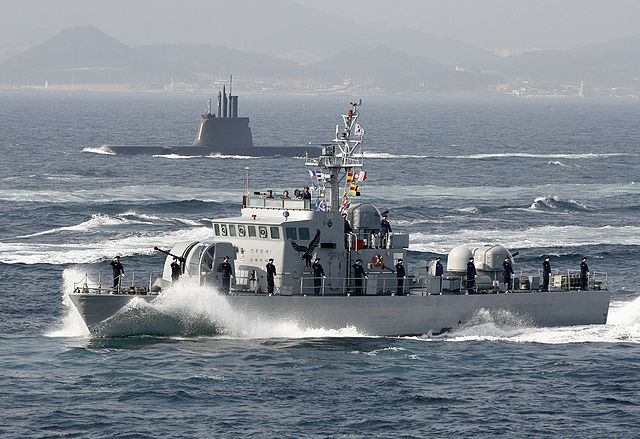
The proverbial South Korean patrol ship. Preceded by former Asheville class PBs used as FAC(M) or fast attack craft (Missile), PG-96, transferred in 1971 and renamed Paek ku 2 and the Paek ku PSSM type FACs built in Korea, the Chamsuri or PKM boats were built by the Hanjin Industrial SB, Chinhae, and Korea SB & Eng. Masan shipyards, 100 in all over the years, since 1978 and until the 1990s, before being replaced by the Yoon Youngha-class from 2008.
Also referred to as patrol killer medium or “PKM”, they were sub-classes, the 201 series and better armed 301 series. initial armament was a single 40 mm/60 Bofors Mk.3, and twin 30 mm/75 Emerlec EX-30, plus two 20 mm/70 Oerlikon Mk.10 AA. They were just basically gunboats. The 301 series (PKM 201) boats had no Bofors, a twin 30 mm/75 Emerlec EX-30, 1/2 turreted single 20 mm Vulcan Gatling CIWS, two 12.7 mm 0.5 cal M2HB Browning machine guns while the last serie had a single turreted 40 mm/60 Bofors and single 20 mm Vulcan Gatlingplus two Browning M2HB and two single 7.62 mm M60 machine guns as a result of the battle of Yeonpyeong.
About only 50 are still in service today, modernized and many were exported: Bangladesh (Titas class, 4), East Timor (3), Ghana (Stephen Otu), Kazakhstan (031 class, 3), Philippines (Tomas Batillo class, 8).
- Displacement: 1000 t standard, 1200t FL
- Dimensions: 87.7 x 10 x 2.88 m
- Powerplant: 2 shaft CODOG, 1 GE LM 2500 GT, 2 MTU diesels
- Performances: 27,800+6,200 shp, 31 knots 4000 nm/15 knots
- Armament: 1x 76 mm OTO, 1x 40mm Mk3 bofors, 2×3 CIWS Vulcan
- Electronics: Raytheon SPS-64(V), HSA WM-28
- Crew: 72
https://en.wikipedia.org/wiki/Chamsuri-class_patrol_boat
https://www.navypedia.org/ships/korea_south/kos_cf.htm
 “Mazinger” class PBs and other coas guard vessels (1978-85)
“Mazinger” class PBs and other coas guard vessels (1978-85)
Three patrol ships #1001-1003 were ordered on 7 November 1980 from Korea Tacoma and hyundai, of steel cosntruction. They displaced 1450 tonnes FL, quite heavy for patrol ships not classes as “corvettes”. They were used by the coast guard. Specs: 1200/1450 tonnes, 80.5 x 9.8 x 3.2 m, Powerplant 2 shaft SEMT Pielstick 12PA6 diesels 9600 bhp 21.5 knots, range 700 nm/18 knots. Armament: Single 40 mm Bofors, 2 x 20 mm Oerlikon, crew 69.
The South Korean Coast guard also operated:
-Six “sea whale” ships 501-507 in service in 1979-82. They displaced 580 tonnes, for 24 knots.
-22 “Shark class” PBs 280 tonnes, 28 knots
-18 “Sea gull” PBs 80 tons, 30 knots
-2 Bukhasan class PBs, modified and modernized versions of the latter
-2 402 class PBs, 430 tonnes, 53.7m, 2 diesels 19 knots, 1x 20 mm Gatling CIWS and 4x 12.7 mm M2HB built by Huyndai and delivered post-cold war (1991).
 Ko jin class PBs (1955)
Ko jin class PBs (1955)
Former PCE 185 feets patrol vessels of the Admirable class. Four were modified in US service as control ships PCEC for landing craft operations: Ro Ryang, Myong Ryang, Han san, Ok Po (1955) and the remainder, Tang po, Pyok Pa, Ryul po and Sa Chon in 1961. Stricken 1977-79.
 Pak Tu San class Sub-chasers (1949)
Pak Tu San class Sub-chasers (1949)
The first ROKN warship of some importance: This was the ex PC-823 (173 ft standard sub-chaser), purchased to the USN for 18,000 $ in 1949 and transferred in 1950. Eight more followed, three from Honolulu during the Korean war, two in 1960 and one in 1964. Han La San was lost during a storm in 1964. The others were stricken in the 1970s.
 Paek Ku class FAC (1975)
Paek Ku class FAC (1975)

The first fast attack crafts of the Korean Navy (Kalmaeki class) were former standard plywood hull PT-23, 25, 26 and 27, transferred in January 1952, renamed Kalmaeki, Kiroki, Olpamei (lost 1952) and Jebi. They were deleted in 1969. Another FAC was the Kilurki 11, built in the USA as a CPIC and named Gireorgi initially she was trialled in the US extensively after being launched at Tacoma in Washington state in 1973. Five more were ti be constructed by Tacoma Korea but none was built and after some service in Korea, the ship was returned to the US.
The main Korean FACS of the 1970s were the Paek Ku class or “Seagulls”, armed with missiles. Numbered Paek Ku 52 to 61, these eight vessels were built in batches in 1975-78. The initial order was place to Tacoma Yard USA for the first three and the design was replicated in Tacoma Yard, Korea for the next five, built with aluminium hulls. They were propelled by six gas turbines TF35 on two shafts, which can be used separately for various speeds and power settings. The Korean models were armed with OTO 76mm/62 OTO guns forwards, a twin 30 mm Emerlec gun plus two .5 cal. M2HB and two twin launchers for Harpoon missiles. They were managed by a Westighouse M1200 fire control system coupled with the LN-66P radar and optical director. The US-built version diverged by having the Mk63 FCS and SPG-50 radar. The prototype paek Ku 52 was launched on 17 February 1975. These ships are deactivated now.
Specifications:
- Displacement: 240 t standard, 268 t FL
- Dimensions: 53.7 x 7.3 x 2.9 m
- Powerplant: 2 shaft COGAG 6 avro Lycoming TF35 gas turbines, 16,800 shp, 40+ knots 2400 nm/18 knots
- Armament: 2 Harpoons SSM, 1x 76mm OTO, see notes.
- Electronics: LN-66HP, SPG-50, see notes
 Su Song class large PBs (1952)
Su Song class large PBs (1952)
Seven former US submarine chasers of the 136 ft type, wooden construction of the YMS type acquired in 1952. Su Song returned to the USA in 1963 two more were decommissioned shortly after arrival in 1955 and the remainder were scrapped in 1970.
 PB class coast guard PBs (1968)
PB class coast guard PBs (1968)
PB-3 – PB-12 were former US sub-chasers , USCG steel-hulled patrol crafts of the 95 tons type used as coast guard patrol crafts transferred in 1968. PB7 was lost after grounding, and the remainder were stricken in 19984.
 Kilkuri class large PBs (1971)
Kilkuri class large PBs (1971)

Kilurki 71 and 72 were built in Korea Tacom Masan in 1971-72 and served until the late 1990s. They displaced 120/140 tonnes FL for 32.9 x 8 x 1.1 m in size, equipped with a machinery counting three shafts on MTU diesels producing 10,200 bhp and 35 knots. Range was 1000 nm at 20 knots. They were armed with a single 40 mm, two .5 cal M2HB HMGs, and two exocet MM38 SSMs. “Kilurki” meant “sea dolphin”.
The next serie Kilurki 211-213 up to 259 (32 ships) were improved versions buult in the late 1970s in the same yard, Chinae. They used PKM as pennant numbers and were able to reach 38 knots. They displaced 133/144 tonnes FL, for a light of 33.1 m, 6.9 m in width and 1.75 m draft. They were propelled by three shafts mated on MTU 13V538 TD90 diesels giving them 6,000 bhp for 34 knots. Range was the same, but the armament varied widely and they carried no missiles as they were classed as “patrol boats” and not “large patrol boats”: 1x 40 mm, 2x 30 mm/85 Emerlec, 2x 20 mm, 2x 12.7 mm M2HB or 2x 30 mm/85 Emerlec, and two 20 mm Vulcan Gatling. Extant in the 1990s, probably partly discarded now.
 Chebi class coastal PBs (1978)
Chebi class coastal PBs (1978)
A serie of thirty-nine small patrol boats built in Pusan (Korea SB) in the late 1970s to the mid-1980s. Called “schoolboy” (Chebi), “sea hawk” and “sea fox” alternatively, they displaced 70 tonnes, 78 tonnes FL for 25.7 m x 5.4 m x 1.2 m in size, and were propelled by two shafts MTU diesels of the same type used on the Kilurki series, for 5200 bhp, 40 knots and an autonomy of 500 nm at 20 knots. They were armd by a 40 mm gun, one 20 mm and four M2HB HMG. Six were stranferred to the Philippines in 1993, six more in 1994, the remainder stayed in service in the 2000s.
 SB/FB coastal PBs (1964-67)
SB/FB coastal PBs (1964-67)
These were two series of ex-US Sewart type coastal patrol crafts called SB-1,2,3 and 5 (40 ft type) and FB 1,2,3 and 5-10, transferred 1964 and 1967 and stricken in 1982.
Mine warfare vessels
 Kang jim class coastal minesweepers (1948)
Kang jim class coastal minesweepers (1948)
Twenty-one ex-YMS wooden built minesweepers were transferred to Korea from 1948 to 1956. In Korean service they had the pennants MSC-501 to 521 and they were in part lost during the Korean war (five), and the remainder stricken in 1977.
 Ha Dong class coastal minesweepers (1950)
Ha Dong class coastal minesweepers (1950)
These were former Bluebird class coastal minesweepers, eight ships built by Peterson in the Wisconsin, specially for MAP transfers. They were transferred 1958-1975 renamed MSC-522-530 abd wooden built with non magnetic fittings. Still in service in the 1990s. Also a single ship, MSB-2 renamed Pi Bong, minesweeping boat was purchased in 1975 and discarded in 1982, mostly for test purposes.
 Kang Keong class minehunters (1986)
Kang Keong class minehunters (1986)

These were the first modern minehunter built in Korea. The class was named KangKeong meaning “swallow”. In all, six ships of 520 tonnes FL were ordered to Kangam Shb. yard, and their design was largely based on the Italian Lerici type. Designing the prototype took time, so much so that the ROKS Kangkeong was two years late, in service by December 1986 and all the other five were completed after the end of the cold war, although plans included ten more. The last was commissioned in April 1994.
They were fitted with two Graymarine Pluto submersibles and GEC-Marconi 193M Mod 1 sonar and Racam-Decca MAINS spotting gear and a GRP hull. They also had a bow thuster for agility. Some authors argues they “plagiarized” the Italian design without official licence.
In 1991 Hyundai was ordered a study for a new class of large and fast minelayers and the design was completed in 1993 with an expected order in 1994 which never came. The ship was 3300 tonnes FL as protected, 104 m long (340ft 6in), armed with Breda guns (76 and 40 mm), 324 mm ASW TTs and an helicopter but no hangar, twin rudders and fin stabilisers.
 Cold war amphibious ships
Cold war amphibious ships
Tae Cho class LSM (1955)
Former Landing ship, medium of the USN, twelve in all, built in 1944-45 and transferred by batches. The first four in 1955 and the rest in 1956. Two were former French Indochina vessels. After the usual period of leasing they were purchased in 1974 but one, scrapped in 1963 (Tok To). Pung To served as a mine warfare HQ, fitted with facilities and mine rails, named LSML, oothers were denominated LSM. To Cho, Tyo To and Ka Tok were stricken in 1972, Pung To in 1984, the others survived in the 1990s, now all scrapped or in reserve.
Kyong Nam class APD (1959)
These six vessels were nominally high speed transports (APD) started as destroyer escorts in 1943-45 and acquired in 1959, 1966 (two) and 1967 (three). They were renamed Kyong Nam, Ah San, Ung po, Kyng Puk, Jonham, chi Ju. Originally rated as gunbaost (PPG) they were modified and renamed APD in 1972 and were fitted to carry 162 troops and four LCVPs. They existed in two configurations with high and low bridge and fitted with tripod masts. Definitive purchase occured in 1974 and they were all stricken in the late 1980s.
Chung Jin class LSSL (1955)
Landing Ship Special, Light – The serie comprised the Chung Jin, Yung Hung Man, Kang Chwa Man, Po Song Man, Yong Il Man transferred in the 1950s and used as gunboats. They were decommissioned in the 1960s. They were used as gunboats.
Si Hung class LSMR class LSSL (1955)
A unique ship denominated LSMR 311, former USS Joseph River (LSMR 527) transferred on ROKN on 15 September 1960 and redesignated LSMR 650, stricken in 1987.
Mulkae class LCU (1966)
Landing ship Utility. Mulkae 71 was the ex LCU-531, transferred in 1966. This vessel was followed by Mulkae 72-78, copies built in South Korea in 1979. They were still in service in the 1990s. It should be added that ten ex-LCM(8) were also transferred in Sept. 1978. New names and fate unknown. Added to this, ten LCM(8) were also transferred in September 1978, still active in the 1990s.


 Latest Facebook Entry -
Latest Facebook Entry -  X(Tweeter) Naval Encyclopedia's deck archive
X(Tweeter) Naval Encyclopedia's deck archive Instagram (@navalencyc)
Instagram (@navalencyc)





 French Navy
French Navy Royal Navy
Royal Navy Russian Navy
Russian Navy Armada Espanola
Armada Espanola Austrian Navy
Austrian Navy K.u.K. Kriegsmarine
K.u.K. Kriegsmarine Dansk Marine
Dansk Marine Nautiko Hellenon
Nautiko Hellenon Koninklije Marine 1870
Koninklije Marine 1870 Marinha do Brasil
Marinha do Brasil Osmanlı Donanması
Osmanlı Donanması Marina Do Peru
Marina Do Peru Marinha do Portugal
Marinha do Portugal Regia Marina 1870
Regia Marina 1870 Nihhon Kaigun 1870
Nihhon Kaigun 1870 Preußische Marine 1870
Preußische Marine 1870 Russkiy Flot 1870
Russkiy Flot 1870 Svenska marinen
Svenska marinen Søværnet
Søværnet Union Navy
Union Navy Confederate Navy
Confederate Navy Armada de Argentina
Armada de Argentina Imperial Chinese Navy
Imperial Chinese Navy Marinha do Portugal
Marinha do Portugal Mexico
Mexico Kaiserliche Marine
Kaiserliche Marine 1898 US Navy
1898 US Navy Sovietskiy Flot
Sovietskiy Flot Royal Canadian Navy
Royal Canadian Navy Royal Australian Navy
Royal Australian Navy RNZN Fleet
RNZN Fleet Chinese Navy 1937
Chinese Navy 1937 Kriegsmarine
Kriegsmarine Chilean Navy
Chilean Navy Danish Navy
Danish Navy Finnish Navy
Finnish Navy Hellenic Navy
Hellenic Navy Polish Navy
Polish Navy Romanian Navy
Romanian Navy Turkish Navy
Turkish Navy Royal Yugoslav Navy
Royal Yugoslav Navy Royal Thai Navy
Royal Thai Navy Minor Navies
Minor Navies Albania
Albania Austria
Austria Belgium
Belgium Columbia
Columbia Costa Rica
Costa Rica Cuba
Cuba Czechoslovakia
Czechoslovakia Dominican Republic
Dominican Republic Haiti
Haiti Hungary
Hungary Honduras
Honduras Estonia
Estonia Iceland
Iceland Eire
Eire Equador
Equador Iran
Iran Iraq
Iraq Latvia
Latvia Liberia
Liberia Lithuania
Lithuania Mandchukuo
Mandchukuo Morocco
Morocco Nicaragua
Nicaragua Persia
Persia San Salvador
San Salvador Sarawak
Sarawak Uruguay
Uruguay Venezuela
Venezuela Zanzibar
Zanzibar Warsaw Pact Navies
Warsaw Pact Navies Bulgaria
Bulgaria Hungary
Hungary

 Bundesmarine
Bundesmarine Dutch Navy
Dutch Navy Hellenic Navy
Hellenic Navy Marina Militare
Marina Militare Yugoslav Navy
Yugoslav Navy Chinese Navy
Chinese Navy Indian Navy
Indian Navy Indonesian Navy
Indonesian Navy JMSDF
JMSDF North Korean Navy
North Korean Navy Pakistani Navy
Pakistani Navy Philippines Navy
Philippines Navy ROKN
ROKN Rep. of Singapore Navy
Rep. of Singapore Navy Taiwanese Navy
Taiwanese Navy IDF Navy
IDF Navy Saudi Navy
Saudi Navy Royal New Zealand Navy
Royal New Zealand Navy Egyptian Navy
Egyptian Navy South African Navy
South African Navy






























 Ukrainian Navy
Ukrainian Navy dbodesign
dbodesign